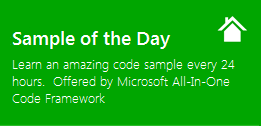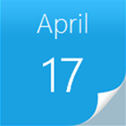[Sample of Apr 17th] Custom date label in ASP.NET Calendar
 |
 |
|
 |
 |
|
Sample Downloads
C# version: https://code.msdn.microsoft.com/CSASPNETDisplayAddtionalTex-3a9f7013
VB version: https://code.msdn.microsoft.com/VBASPNETDisplayAddtionalTex-c7f86fb5
The project illustrates how to display additional text in a calendar control. As we know, people may want to add different customize text when date of Calendar has been selected. Here we give an easy way to set Calendar's specified text, background color, border properties and make Calendar looks better.
The sample was written by our star writer: Arwind Gao
 You can find more code samples that demonstrate the most typical programming scenarios by using Microsoft All-In-One Code Framework Sample Browser or Sample Browser Visual Studio extension. They give you the flexibility to search samples, download samples on demand, manage the downloaded samples in a centralized place, and automatically be notified about sample updates. If it is the first time that you hear about Microsoft All-In-One Code Framework, please watch the introduction video on Microsoft Showcase, or read the introduction on our homepage https://1code.codeplex.com/.
You can find more code samples that demonstrate the most typical programming scenarios by using Microsoft All-In-One Code Framework Sample Browser or Sample Browser Visual Studio extension. They give you the flexibility to search samples, download samples on demand, manage the downloaded samples in a centralized place, and automatically be notified about sample updates. If it is the first time that you hear about Microsoft All-In-One Code Framework, please watch the introduction video on Microsoft Showcase, or read the introduction on our homepage https://1code.codeplex.com/.
Introduction
The project illustrates how to display additional text in a calendar control. As we know, people may want to add different customize text when date of Calendar has been selected. Here we give an easy way to set Calendar's specified text, background color, border properties and make Calendar looks better.
Running the Code
Please follow these demonstration steps below.
Step 1: Open the VBASPNETDisplayAddtionalTextInCalendar.sln.
Step 2: Expand the VBASPNETDisplayAddtionalTextInCalendar web application and press Ctrl + F5 to show the Default.aspx.
Step 3: You can find a Calendar control on the Default.aspx page. Please Click to select one of dates.
Step 4: You will see "your text" in the bottom of every selected date.
Step 5: Validation finished.
Using the Code
Step 1. Create a VB "ASP.NET Empty Web Application" in Visual Studio 2010 or Visual Web Developer 2010. Name it as "VBASPNETDisplayAddtionalTextInCalendar".
Step 2. Add one web form in the root directory, name it as "Default.aspx".
Step 3. Add a Calendar control and a button on default page, The calendar control display the selected dates and additional text, The Button is use to output all selected dates.
Step 4. Define a list of DateTime instances for storing selected dates. The List<DateTime> variable store in ViewState.
' Define a list of DateTime to store selected date.
Dim SelectDates As New List(Of DateTime)()
''' <summary>
''' The selected dates is stored in ViewState.
''' </summary>
Public Property GetDateTimeList() As List(Of DateTime)
Get
If ViewState("SelectDate") Is Nothing Then
Dim selectdates As New List(Of DateTime)()
selectdates.Add(DateTime.MaxValue)
ViewState("SelectDate") = selectdates
End If
Return DirectCast(ViewState("SelectDate"), List(Of DateTime))
End Get
Set(ByVal value As List(Of DateTime))
ViewState("SelectDate") = value
End Set
End Property
Step 5 Add Calendar SelectionChanged, PreRender, DayRender event to add
date time in selected date list or remove date from it.
[code]
''' <summary>
''' Calendar SelectionChanged event, add new date in SelectedDate and
''' remove the same date.
''' </summary>
''' <param name="sender"></param>
''' <param name="e"></param>
Protected Sub myCalendar_SelectionChanged(ByVal sender As Object, ByVal e As EventArgs)
Dim dateSeletion As DateTime = myCalendar.SelectedDate
If SelectDates.Contains(dateSeletion) Then
SelectDates.Remove(dateSeletion)
Else
SelectDates.Add(dateSeletion)
End If
End Sub
''' <summary>
''' Clear selected dates.
''' </summary>
''' <param name="sender"></param>
''' <param name="e"></param>
Protected Sub myCalendar_PreRender(ByVal sender As Object, ByVal e As EventArgs)
myCalendar.SelectedDates.Clear()
End Sub
''' <summary>
''' Add your customize text in Calendar control.
''' </summary>
''' <param name="sender"></param>
''' <param name="e"></param>
Protected Sub myCalendar_DayRender(ByVal sender As Object, ByVal e As DayRenderEventArgs)
For Each time As DateTime In SelectDates
myCalendar.SelectedDates.Add(time)
If e.Day.[Date] = time Then
e.Cell.BorderWidth = 1
e.Cell.BackColor = Color.SlateBlue
e.Cell.Controls.Add(New LiteralControl("<br />your text"))
End If
Next
End Sub
Step 6. Add button's click event, the button will display the selected dates
on default page, actually we may store them in database or xml files.
Here we only output them.
[code]
''' <summary>
''' render selected dates.
''' </summary>
''' <param name="sender"></param>
''' <param name="e"></param>
Protected Sub btnCheck_Click(ByVal sender As Object, ByVal e As EventArgs)
For Each [date] As DateTime In SelectDates
If [date] <> DateTime.MaxValue Then
Response.Write([date].ToShortDateString())
Response.Write("<br />")
End If
Next
End Sub
Step 7. Build the application and you can debug it.
More Information
MSDN: Calendar Class
https://msdn.microsoft.com/en-us/library/system.web.ui.webcontrols.calendar(VS.80).aspx
MSDN: Calendar.SelectionChanged Event
https://msdn.microsoft.com/en-us/library/system.web.ui.webcontrols.calendar.selectionchanged.aspx
MSDN: Control.PreRender Event
https://msdn.microsoft.com/en-us/library/system.web.ui.control.prerender.aspx
MSDN: Calendar.DayRender Event
https://msdn.microsoft.com/en-us/library/system.web.ui.webcontrols.calendar.dayrender.aspx